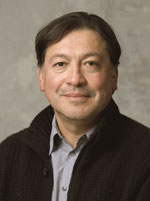Professor Julio A. Ramirez to lead Purdue's team in NSF NEES grand challenge project
December 6, 2006 -- The National Science Foundation (NSF) has awarded $3.6 million to a multi-institutional team led by UC Berkeley's Pacific Earthquake Engineering Research Center for a five-year study to mitigate collapse risk of older nonductile concrete buildings during earthquakes.

Non-ductile concrete buildings were a prevalent construction type in highly seismic zones of the U.S. prior to enforcement of codes for ductile concrete in the mid-1970s, and are widespread in many countries. In California, alone, it is estimated there are 40,000 of these buildings, including residential, commercial and critical service facilities. The poor seismic performance of nonductile concrete buildings was evident in recent earthquakes including Northridge (1994); Kobe, Japan (1995); Chi Chi, Taiwan (1999); Kocaeli, Turkey (1999); Sumatra (2005); and Pakistan (2005).
For this project, a multi-disciplinary and multi-institutional team will study the vulnerability and toughening of nonductile concrete infrastructure against earthquake effects. Specifically, the team will develop procedures to identify the truly dangerous buildings from among the large building population, thereby turning an intractable problem into one that can be addressed with available resources. Mitigation strategies developed here also can inform strategies to mitigate for other natural and manmade hazards such as hurricanes and explosions.
"Existing vulnerable buildings are the number one seismic safety problem in the world, and nonductile reinforced concrete buildings are a noteworthy percentage of these that have yet to be addressed in a systematic way," said Jack Moehle, the project team leader from UC Berkeley. "This project will tackle this issue in a comprehensive way, leading to solutions that can save thousands of lives."
According to Joy Pauschke, Program Director of NEES at NSF, "We have learned the lesson over and over again in past earthquakes in the U.S. and abroad that many of our nation's older concrete buildings, where many of us live and work, are not safe during an earthquake. This project will use the NSF-funded NEES laboratories around the U.S. to provide building owners, occupants, and public officials with solutions to make these buildings safer."
NSF established the George E. Brown Jr. Network for Earthquake Engineering Simulation (NEES) as a national distributed laboratory to accelerate progress in understanding earthquakes and their effects. NEES is a shared network of fifteen experimental facilities, collaborative tools, a centralized data repository, and earthquake simulation software, all linked by the ultra high-speed Internet2 connections of NEESgrid. Berkeley is home to one of the 15 NEES laboratories.
At Purdue University, the project team is led by co-PI Professor Julio Ramirez (School of Civil Engineering) who will study shear and axial failures of older-type reinforced concrete columns, as well as simple retrofitting techniques for delaying axial failure in poorly reinforced columns. Professor Ramirez is also the building components research coordinator for the overall NEES Grand Challenge project and has the US/Global engineering community liaison assignment. Additional project team members are from UC Berkeley, San Jose State University, UCLA, UC San Diego, the University of Kansas, University of Puerto Rico, Mayaguez, USC, and University of Washington.
The project team is partnering with the Earthquake Engineering Research Institute (EERI) to form the Concrete Coalition, an alliance of concerned engineers, planners, policy experts, and other stakeholders who will work with the project team to develop and implement effective mitigation strategies.
Expected outcomes of the study include improved inventory, data and models for components and subsystems, single building simulation capabilities, improved fragilities/regional simulations, public policy, improved engineering assessment and retrofit tools, increased diversity in earthquake engineering, and active rehabilitation of truly vulnerable buildings nationwide initiated through public policy and professional encouragement.
The project is being organized within the Pacific Earthquake Engineering Research Center (PEER), a national earthquake engineering research center with headquarters at the University of California, Berkeley, and funding from sources including the U.S. National Science Foundation, the State of California, participating universities, private industry and business partners.
